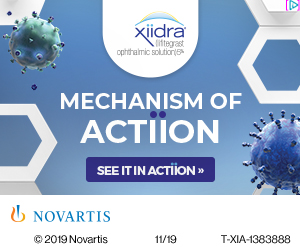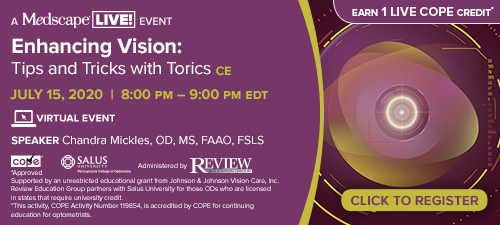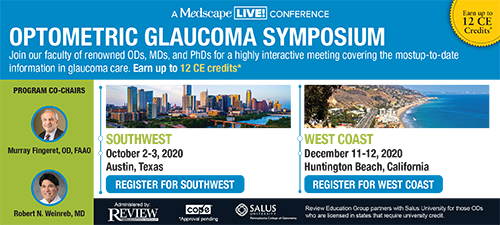
A
weekly e-journal by Art Epstein, OD, FAAO
Off the Cuff: COVID-19 – Important Update
Despite what you may have thought or hoped, the COVID outbreak is unlikely to go away any time soon. If you haven’t yet heard, Vision Expo West was just cancelled. Barring a miracle cure or vaccine that makes it through testing without killing a majority of volunteers, I suspect every meeting for the remainder of this year and probably well into 2021 will be cancelled. Things will undoubtedly get worse before they get better. Considering the amount of politically agendized and often weaponized COVID news in the mainstream media, it’s hard to know whom or what to believe. The scientific literature isn’t that much better. For example, the well-publicized studies of hydroxychloroquine were tainted by severe overdosing of treated patients. This was a likely cause of, or contributor to, the higher incidence of fatalities reported. Much of the initial data from China has not been substantiated. We’re now seeing greater infection rates among younger patients than the elderly, despite initial reports. And while COVID deaths fill the headlines, fatality rates—even in the hardest hit areas like Arizona—are still less than 3 in 10,000 or .03% of the population. That said, COVID can be deadly and you don’t want to catch or spread it. As I shared a few months back, contrary to guidance from federal and state authorities, viral transmission from touching contaminated surfaces is extremely unlikely. COVID-19 is an airborne aerosolized virus that spreads by rebreathing an infected person’s exhaled breath. Finally, after an open letter signed by 239 concerned scientists from 32 countries published this past week, the WHO finally admitted that coronavirus is airborne and travels long distances. What that means is the small, cramped spaces that we typically work in increase our risk of infection. Now that this has been confirmed, you may want to seriously consider adding a high-capacity HEPA air purification system to exam rooms and other confined areas in your office. Dr. Jenifer Ramsower, a colleague who practices in Florida, initially gave me the idea for my IPL treatment room. We have since added systems in every exam room with the ability to completely turn over room air in less than 10 minutes. Expect HEPA-based systems to be in high demand once this sinks in. As the situation continues to evolve, I will share what I learn. Your comments and suggestions are also welcomed. The more we know, the safer we and our patients will be.
|
|||||
 |
||
| Eyelid Disorders in Ophthalmology Practice: Results from a Large International Epidemiological Study in Eleven Countries | ||||
Anecdotal evidence suggests that eyelid disorders are common, although estimates of prevalence vary. The current study determined the prevalence of eyelid disorders, meibomian gland dysfunction (MGD) and related diseases (specifically ocular surface disease) in a population of patients presenting for routine ophthalmologic consultations. This cross-sectional epidemiologic survey evaluated patients presenting for routine ophthalmic visits. During the consultation, an ophthalmologist completed a questionnaire, and each patient underwent an ophthalmic examination and completed a quality of life questionnaire. A total of 349 ophthalmologists, recruited from 11 countries, provided data on 6,525 patients. Patients were predominantly females (61.6%). The mean age of the study population was 57.0 ± 17.6 years. Eyelid disorders were diagnosed in 5,109 (78.3%) patients and were statistically associated with: atopic dermatitis, seborrheic dermatitis, dry eye, age-related macular degeneration, diabetes, cataract, allergy and MGD. Eyelid abnormalities were identified in 59.6% of patients; conjunctival or corneal abnormalities were observed in 64.9% and 28.1% of patients, respectively. MGD was diagnosed in 54.3% patients and was statistically significantly associated with the presence of eyelid disorders and eyelid margin abnormalities. Dry eye was diagnosed in 61.8% of patients. Concurrent dry eye and MGD were present in 67.6% of patients. Most patients reported some degree of impaired vision and daily/work activities related to dry eye. Impact on contact lens usage, emotions and quality of sleep was also reported. The effects on daily life were associated with the presence of MGD. |
||||
SOURCE: Doan S, Zagórski Z, Palmares J, et al. Eyelid disorders in ophthalmology practice: results from a large international epidemiological study in eleven countries. Ophthalmol Ther. 2020; Jul 1. [Epub ahead of print]. |
||||
 |
||
| Evaluating Goldmann Applanation Tonometry Intraocular Pressure Measurement Agreement Between Ophthalmic Technicians and Physicians | ||||
These researchers examined intraocular pressure (IOP) measurement disagreement between technicians and physicians, and the impact of an educational intervention on the short and long-term disagreement in IOP measurement using Goldmann applanation tonometry. This study was conducted at a glaucoma clinic at a university hospital with six technicians and two physicians. An educational intervention was implemented for the technicians to try to improve IOP measurement agreement with physicians. Frequency of IOP measurement disagreement between physicians and technicians, defined as a difference in IOP of >2 or >3 mmHg and assessed at baseline, immediately and six months post-intervention were evaluated. IOP was evaluated for a total of 529 eyes (physician measured mean IOP=16.4 mmHg [SD=5.9]), 30 per technician-physician pair for each data collection period: baseline, immediately post-intervention and six months post-intervention. At baseline, physicians disagreed 17% and 7% of the time when measuring IOP using >2 and >3 mmHg to define disagreement, respectively, while the average disagreement between technicians and physicians was 25% and 13%. Disagreement was greater at IOPs over 20 mmHg. No significant changes were noted in the frequency of disagreement between technicians and physicians immediately or six months post-intervention. Two physicians measuring the same patient in the same room disagreed by >2 mmHg in 17% of patients' eyes, and this amount of disagreement was even higher when comparing physicians to certified technicians. An educational intervention did not improve agreement in IOP measurements between technicians and physicians. This highlighted an important limitation of Goldmann tonometry.
|
||||
SOURCE: Mihailovic A, Varadaraj V, Ramulu PY, et al. Evaluating Goldmann applanation tonometry intraocular pressure measurement agreement between ophthalmic technicians and physicians. Am J Ophthalmol. 2020;S0002-9394(20)30337-8. |
||||
 |
||
| Association Between Intraocular Lens Diopter and Posterior Capsular Opacification | ||||
Researchers wrote that posterior capsular opacification (PCO) is the most common complication after cataract surgery. They aimed to assess the relationship between intraocular lens (IOL) diopter and formation of PCO among a consecutive real-world registry. Included were 14,264 consecutive cases of uncomplicated cataract surgery performed from 2014 to 2018 in Helsinki University Hospital in Finland. Nd:YAG capsulotomies were used as an estimate of clinically significant PCO. A single eye of each patient and a single type of IOL were included. Mean age was 73.2 ± 9.9 years and 61.8% were female. Mean follow-up time was 25.4 ± 16.8 months. Overall PCO rates were 1.1% at one year, 3.0% at two years, 7.1% at three years and 10.2% at four years. Patients with IOL diopters (D) in the lower quartile (≤ 20.0D) had significantly higher rates of PCO (1.3% at one year, 4.4% at two years, 9.4% at three years and 14.2% at four years). A logistic regression model showed increased risk for PCO formation with lower diopter IOLs; for ≤20.0D: OR 1.343 (95% CI: 1.132 to 1.593), for ≤10.0D: OR 2.409 (95% CI: 1.203 to 4.287), p<0.001 for all comparisons. In a multivariant regression accounting for possible confounders, results remained consistent. Among a cohort of patients undergoing cataract surgery, use of lower diopter IOLs was associated with increased incidence of clinically significant PCO. Researchers suggested that research into IOL biomechanics to decrease PCO may be warranted especially in lower diopter IOLs. |
||||
SOURCE: Hecht I, Dubinsky-Pertzov B, Karesvuo P, et al. Association between intraocular lens diopter and posterior capsular opacification. Clin Exp Ophthalmol. 2020; Jul 8. [Enews ahead of print]. |
||||
| News & Notes | ||||||||
| Vision Expo West Canceled The Vision Council and Reed Exhibitions, organizers of Vision Expo, announced the decision to cancel Vision Expo West 2020, scheduled to take place in Las Vegas from Sept. 23 to 26. According to a statement on the meeting website, Reed Exhibitions’ Vision Expo team and The Vision Council worked together to prepare and plan for the event while closely monitoring the COVID-19 pandemic and its impact on members of the optical community. With the health and wellbeing of everyone in attendance at the show as the show organizers’ primary concern, Vision Expo, along with the Venetian Resort, developed an in-depth plan to ensure the safety of everyone planning on attending. Despite these efforts and a strong interest from the industry to participate, the decision was made to cancel Vision Expo West 2020 as a result of Nevada Governor Steve Sisolak’s June 26 announcement sharing that Nevada “will remain in Phase 2 of reopening plans through the end of July due to current trends of the coronavirus infection.” Read more. |
||||||||
|
||||||||
| Coburn Announces New Velocity LTE Spin Coating System e Coburn Technologies released the newest edition of its Velocity coating platform — the Velocity LTE Spin Coating System — a space-saving, semi-automated spin coater that helps support the needs of small to mid-sized labs. The Velocity LTE offers the same coating technology as the flagship Velocity platform at a lower price and in a smaller footprint. The Velocity LTE features an individual control board for each of its three spindles. Each spindle circulates automatically through three stations: wash, coat and UV-cure. Spindle speed can be adjusted through the machine’s operator screen, offering more control of the coating process. The system can process 80 lenses per hour, features an auto-priming function and is designed to eliminate overspray. Learn more.
|
||||||||
|
Optometric Physician™ (OP) newsletter is owned and published by Dr. Arthur Epstein. It is distributed by the Review Group, a Division of Jobson Medical Information LLC (JMI), 19 Campus Boulevard, Newtown Square, PA 19073. HOW TO ADVERTISE |



